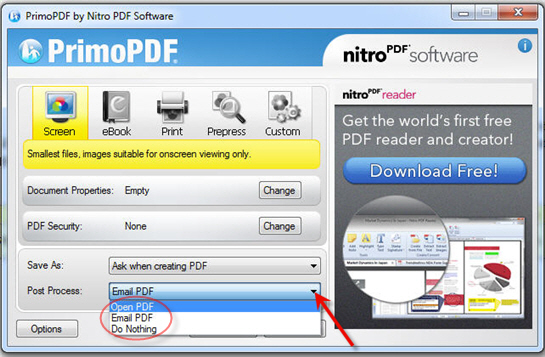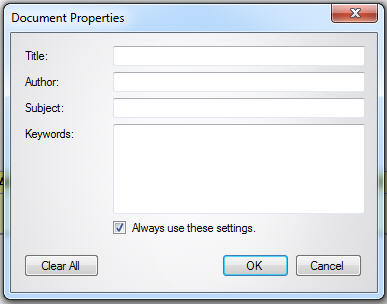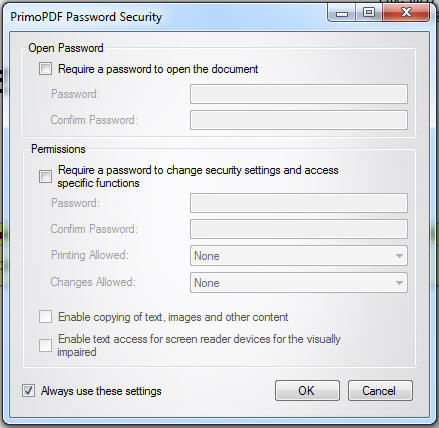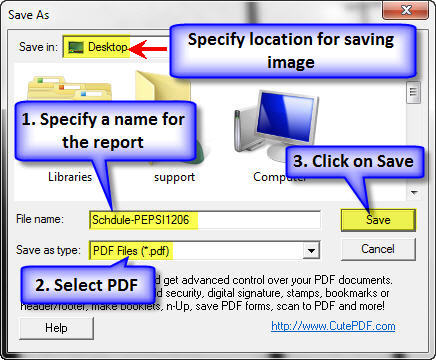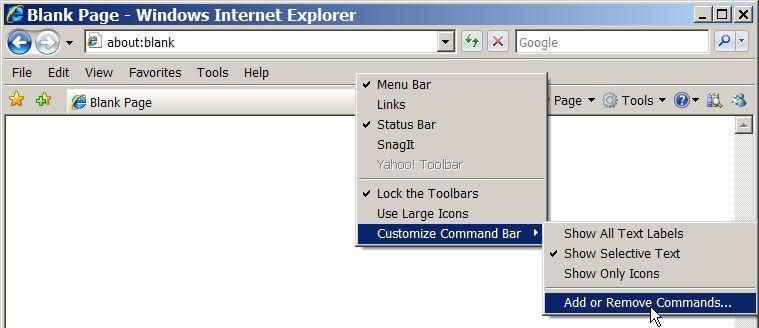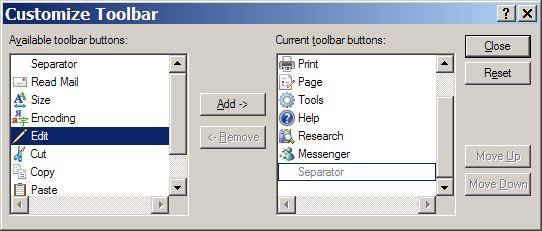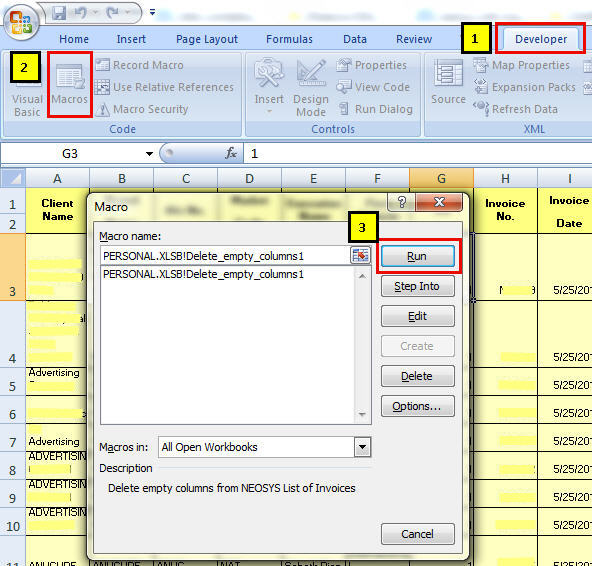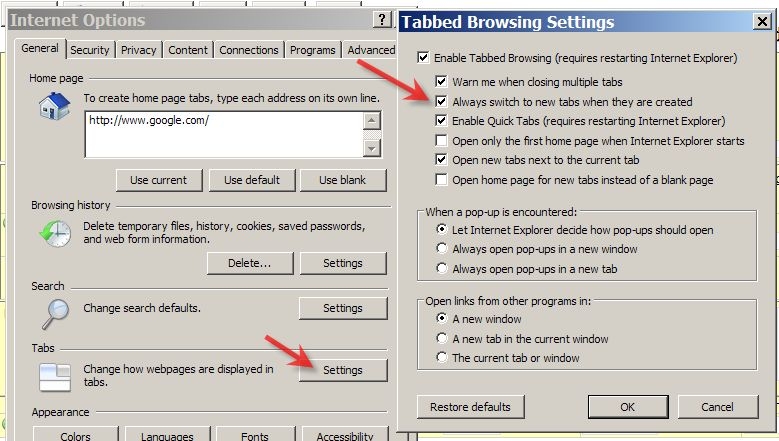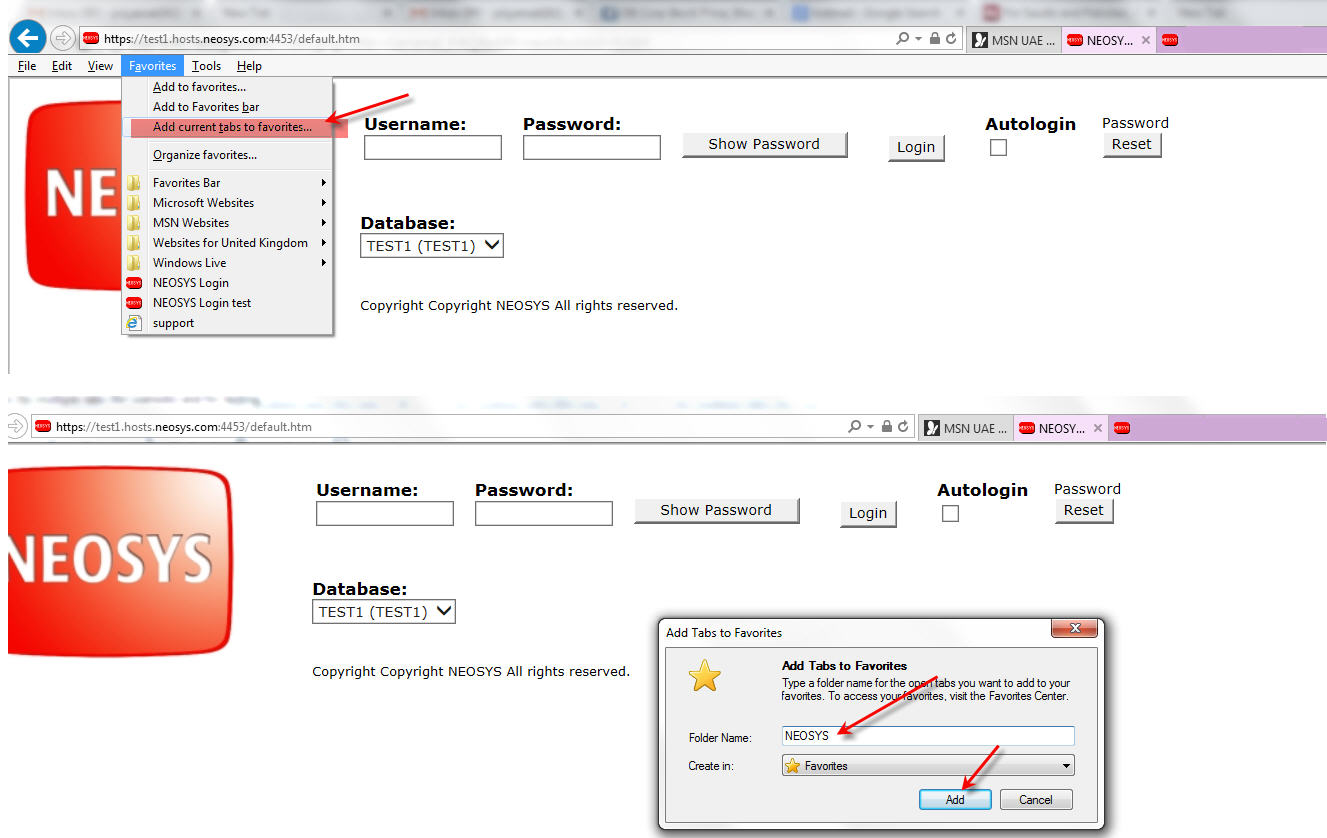Using NEOSYS Generally
Getting started with NEOSYS
- Reset your browser to factory settings to ensure all 3rd party toolbars/pop-up blockers are removed and browser cache is cleared. See Reset Browser for instructions.
- Reopen the browser ensure that the pop-up blocker is disabled. See Disabling Popup Blocker for instructions.
- Enter the NEOSYS URL.
- Add this URL to your favourites.
- You should now see the Login page. If you are a new user or have forgotten your password click on Request Password for instructions on how to get your password
- Enter your Username, Password, select the database and click on login. See http://youtu.be/dS62_eSCm-A to learn how to login to NEOSYS.
- You should now see the user details page.
Using the NEOSYS testing and training database
Standard NEOSYS practice is to setup a "testing and training" database for each operationally live database. This testing and training database is very useful to try out procedures in NEOSYS without having any real live or permanent effect. The testing and training database is virtually a copy of the live data because every night the live database is cloned over (copied) to the test database. This database is generally available to everybody who has access to the live database unless specifically restricted.
- To access the test database, first log out of the live database if you are logged in, then chose the test database from the dropdown on the login screen before logging in.
- Since the test database is a copy of the live database as at last night (around 1am) it contains up to date info for you to play with any time you like.
- Any work you do in the test database has no effect whatever in your live database.
- There is no way to copy any work done in the test database to the live database
- Since any testing work done in the test database will be OVERWRITTEN during the night, if you wish to perform extended testing which extends overnight, you can ask NEOSYS support to suspend the nightly copy.
- Passwords in the test database are a COPY of whatever was in the live database at the time it was copied (usually last night). Resetting the password in LIVE or TEST does not affect the other database.
- Documents and reports generated from the test database have a mark (in red) in the heading to indicate that they did not come from the live system. This helps to reduce confusion in case people lose track of which system they are working in.
Screen logging in to test database:
Document showing red warning in heading:
Restricting user access to files
Restricting user’s access to certain records of a file depending on company/division
In the following discussion remember that NEOSYS “companies” are used to implement any kind of corporate division. This includes legal entities and any type of internal division including departments, cost centres and profit centres etc.
Step 1 is to use the NEOSYS Authorisation File to generally restrict users access to certain companies/divisions, then they will also be restricted from viewing any records “belonging” to those companies/divisions. Split the groups in the authorisation file into multiple groups per division. For example, instead of one CLIENT SERVICE group in the Authorisation File you can create CLIENT SERVICE1, CLIENT SERVICE2 etc. The only difference must be a trailing integer so that the actual division name can be determined by NEOSYS.
For example to restrict access to company/division “XYZ” you create locked tasks in the NEOSYS Authorisation File as follows. The quotation marks are required.
COMPANY ACCESS “XYZ”
Invent a suitable lock eg =CFX to lock this company, place that lock on the newly created task and add that lock to the keys of the groups that should have access to that company.
Step 2 - Most of the various files in NEOSYS allow, and sometimes require, the association (i.e. tying) of individual records to specific companies/divisions either directly or indirectly.
Depending on the file, restrict access by entering one or more of the following on the individual records that are to be restricted.
- Company code
- A/c No. of an account which is tied to a specific company/division in its chart of accounts
- ”A/c No , company code” eg 99999,XYZ - in most places that you can enter the A/c No. you may also follow it with a comma then the company code.
- Codes of other records which are themselves tied to a specific company/division.
Important Note: brands are associated with the company of the account at the time that the brand was created and removing the company from the account code didnt free up the brand from the company which also includes removing the company code from the chart. Hence if you do such a change you need to run the following in maintenance mode:
F5 CREATEBRANDS Yes
Restricting access of users to specific individual records
Insert locked tasks in the Authorisation File similar to the following. For example, the following restricts access to company “XYZ”. The quotation marks are required.
COMPANY ACCESS “XYZ”
Generally, wherever there is a task called ‘filename ACCESS’ then you can add tasks like ‘filename ACCESS “XYZ” ’ to restrict access to individual records.
Other examples are:
ACCOUNT ACCESS “99999” MARKET ACCESS “INT”
Restricting access to the company and market files is rather special in that it also restricts access to any and all records associated with (ie “belonging” to or tied to) that company or market.
Due to limitations in the size of the authorisation file, this should be limited to no more than a few 10’s of records in total for all files.
Using NEOSYS online
Slow speed initially
The first time you use NEOSYS it takes time to get to the login screen because software code has to be downloaded in to the workstations browser cache. Getting to the login screen subsequently will be much faster.
After you login, there is also a delay the very first time that you bring a form (any form) on screen. The workstation has to download the general form handling software that handles all forms.
There is also a delay the very first time you use each specific form while the form specific software is downloaded. Large more complex forms take longer than smaller more simple forms.
Tips for demo
Login and get *any* small form up before the full demo starts then close all windows to start the demo from scratch. If possible also visit as many of the larger forms as you can before the full demo starts
During the demo, if any screen comes up slowly, change to another screen and then go back to the original screen to show that it is fast on the second and subsequent visits.
Use shift+click or right mouse click on the menu to open new windows wherever possible rather than keep changing forms within one window.
Be aware that large complicated forms take longer to download initially but all forms should be fast on secondary visits.
Common error and solution
Sometimes, especially on poor internet connections, NEOSYS doesn't download all the files correctly from Win3 immediately. If this happens you will get a variety of different error messages when you use the system first. You might also get no message but a little warning flag at the bottom of the internet explorer window that says something like "error on page".
The problem is usually resolved by revisiting the page or pressing the F5 button or the Refresh button on the Internet Explorer tool bar
Emailing documents in PDF format
OPTION 1 : Using "PrimoPDF"
Features
- - - - PrimoPDF Must be installed on each user's computer
- +++ Free version (7.2 MB) without any time limitation/adware etc.
- +++ Well supported including Vista with paid version available
- +++ Minimal clicks to accomplish the task (easy to use)
- +++ Option to "Email PDF" directly
- +++ Options to password protect reading/updating
Installation
http://www.neosys.com/software/primopdf.exe (changes)
http://www.neosys.com/software/primopdf4.0.1.exe
You probably also want a pdf viewer installed
http://www.adobe.com/products/reader/
Setting up
- Optionally set PrimoPDF to be your default printer
- Optionally configure your default printer to be landscape mode
- Set the PrimoPDF "Post Process" to be "Email PDF"
- Optionally setup other PrimoPDF options - for example password protection etc
Using
1. Get on screen the document that you want to send.
2. Click Print and select PrimoPDF from the list of printers.
3. Wait for the PrimoPDF screen to open.
4. You have the option to choose a specific folder to save the PDF you are about to create prior to emailing as shown below. All PDF documents you generate henceforth would automatically get saved at this convenient location.
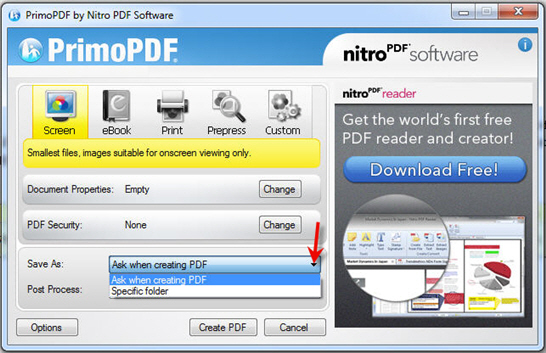
5. Select the post process task from the drop down menu as shown below :
6. If you choose "Email PDF", a blank email template will open up with the attached PDF document you just created.
7. Fill in the desired email address/subject etc.
8. Click Send.
As mentioned earlier, PrimoPDF also allows a user to password protect the document and add document properties by simply clicking "Change" next to the respective options as can be seen in the screenshots above.
Here are screenshots of the "Document Properties" and "PrimoPDF Password Security" windows :
OPTION 2 : Using "CutePDF"
CutePDF Writer allows you to convert any printable document to PDF format. It installs as a virtual printer and is available from any application that offers a `Print` option. The program is easy to use, just select the CutePDF printer and click the print button. CutePDF Writer depends on the install of a PS2PDF converter such as Ghostscript (a small conversion utility) which can be automatically downloaded and installed during setup.
Features
- - - - CutePDF Must be installed on each user's computer
- +++ Free version without any time limitation/adware etc.
- +++ Very light to download and install.
- - - - No option to “Email PDF” directly. File must be saved first and can be attached later to email.
- +++ Supports Microsoft Windows XP/2003/Vista/7 (x86/x64)
Installation
Free Download (3.83 MB) at : http://www.cutepdf.com/
Using CutePDF
As Cute PDF Writer installs itself as a printer on your computer, it enables you to create a PDF document out of anything you can print.
- Get on screen the document you wish to email and click on File -> Print (Control + P)
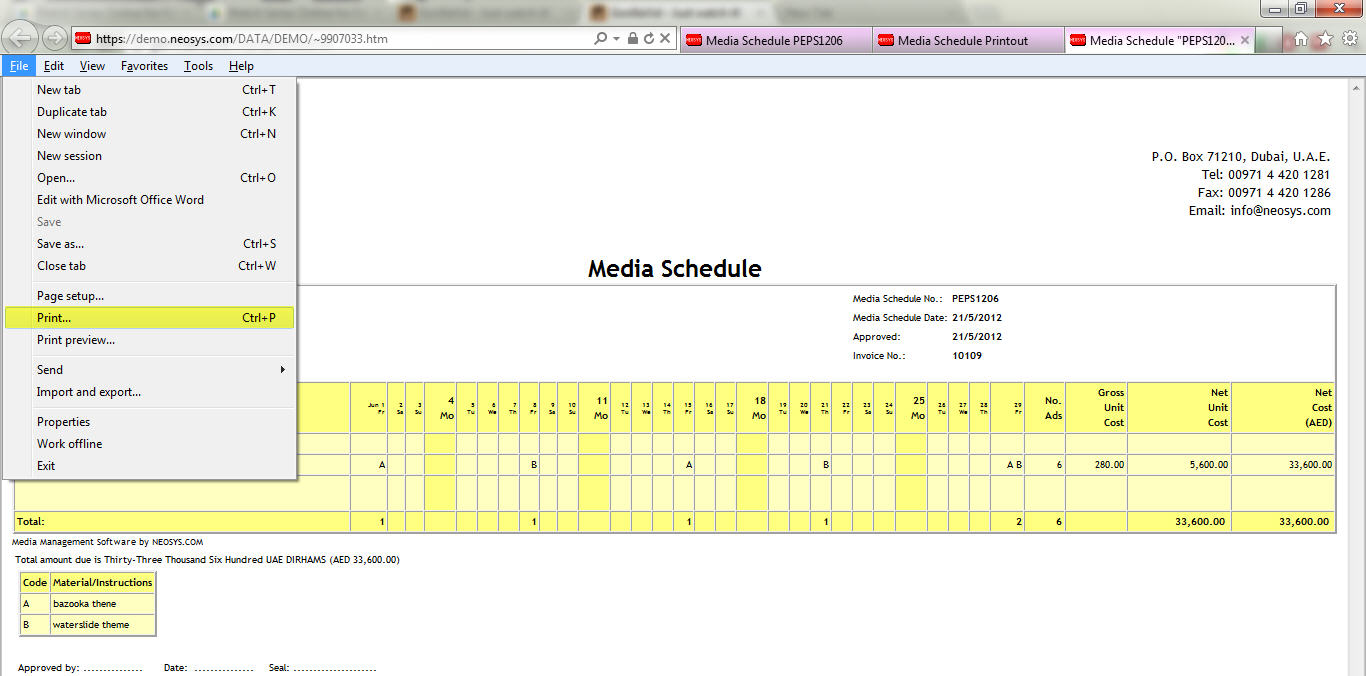
- Select "CutePDF Writer" from the list of printers and Click on Print
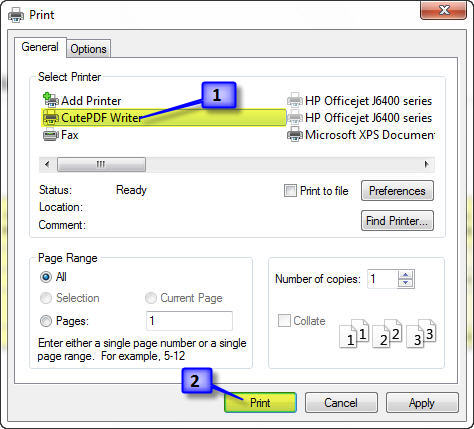
- After sending it to print, a box pops up:
- This PDF document can now be sent as an attachment via email.
Codes in NEOSYS
Inventing codes
In order to speed up data entry, NEOSYS usually allows codes to be entered directly instead of relying on name searches and popups which are slower.
There are three strategies to invent codes:
- Sequential numbers. Easy to generate codes for new records but the codes are difficult to remember and are meaningless
- Meaningful codes. Invent a pretty code so that when you look at the code it reminds you of the name. There are many alternatives though and it is usually difficult later on to re-guess/remember the exact code given only the name.
- Meaningless codes. Use some mechanical rule for generating a code from the name. If the rule is simple, then later on we can re-guess the code from the name easily. Unfortunately looking at the code usually does not remind us of the name.
The real aim of coding, if you think about it for a while, is to be able to know the code to enter it quickly even if all you know is the name. Therefore method three is the most useful.
Surprisingly, the main aim is NOT to know the name on seeing the code which is natural instinct of most people when coding. Meaningful codes are indeed pretty but usually it is difficult to remember the exact code for data entry.
Interestingly, it is common to find NEOSYS clients who have never met each other to be using identical codes for the same clients and suppliers etc.
Using Four letter coding system
This four letter coding system has proven over many years to be easy to use and surprisingly good at avoiding duplicate codes where there are thousands of records.
Follow these steps rigorously:
- If there is a well known abbreviation for something use that regardless of how many letters there are. e.g. IBM or UNESCO
- Remove all standard words from the name to be encoded. Egg The, Company, Al, Incorporated, Ltd etc
- If there is only one word left in the name take the first four letters otherwise take the first two letters of the first two words and ignore any following words.
- ACCIDENTAL DUPLICATIONS: If the code accidentally duplicates with another code, simply add a 2 or 3 or 4 onto the end of the code. DO NOT INVENT YOUR OWN CODES.
- PREDICTABLE DUPLICATIONS: If you know in advance that there are several similar accounts with almost the same name then first use the four letter rules rigorously ... and then add two letters e.g. country, town, currency etc to distinguish the duplicates.
Examples of four letter coding
NESO - NEOSYS Software Ltd. (rule 3: easy to take the first two letters of the first two words)
KHAL - Al Khaleej (rule 2 and 3: Remove the standard word Al and take the first four letters of the only word)
IBM - IBM Corporation (rule 1: Standard abbreviation although in practice would probably have a geographical location appended)
STBU - Stephen Bush (rule 3: Personal names code well in using four letters)
STBU2 - Stephan Butros (Rule 4: An accidental duplication .. simply add 2)
GUOIDU - Gulf Oil Dubai (Rule 5: We know there are many Gulf Oil records so we add two letters for the location)
GIOIJE - Gulf Oil Jeddah (Rule 5:)
What is NEOSYS password policy?
NEOSYS automatically generates short, memorable passwords for users and sends them to their registered corporate email address. Users can request their initial password, or a new password, at any time as long as their account is valid.
A NEOSYS automatically generated password is a four letter "word" in the pattern "CVCV" - consonant, vowel, consonant, vowel. These are short and memorable like "KYLA". This reduces the occurrence of users noting down their passwords in insecure locations and therefore tends to increase overall security. Also, since users cannot pick their own passwords, weak passwords are avoided thereby tending to increase overall security.
Three failures to login, for whatever reason, causes a user account to become locked until a new password is requested. Automatic lockout makes password guessing attacks infeasible despite the shortness of the NEOSYS password. Users can unlock their own account by simply requesting a new password.
When a login is refused, no specific reason is given, only a message that lists all the possible reasons for login failures. Either the username or password is incorrect or the account has been locked and a password reset should be done. Not being told the specific reason for failure to login is rather unhelpful for legitimate users but it is considered to be a standard security practice to avoid providing any information that might facilitate unauthorised access attempts.
Users can update their own email address, but only after logging in successfully, and only to the companies corporate email servers. The email address part after the @ sign is restricted. This prevents password resets being sent to third party email systems which are outside the control of the company (like gmail.com etc.) unless specifically allowed.
Forcing users to change password regularly
Enforcing periodic change of user passwords is an optional policy set per database in NEOSYS. The maximum number of days between password changes can be set and applies to all users. If a user does not change their password within the maximum period then their account is locked and they cannot login until they request a new password in the usual way from the login screen.
Enforcing periodic change of user password is often considered an essential component (but only a component) of overall computer security. The concept is that people who improperly gain, or retain, access to the system, but do not have access to corporate email and therefore are unable to avoid password expiry, will not have access permanently.
For example: Someone leaves the company and a) has been been granted partial or unrestricted access to NEOSYS from outside the office and therefore continues to have physical access to NEOSYS despite having left the company and b) has not been removed or expired from the NEOSYS authorisation table due to administrative oversight. In this case, the person will *not* have permanent access to the system because they will not be able to renew their NEOSYS password because, having left the company, they no longer have access to their corporate email account. Note however that THEY WILL HAVE ACCESS although for a limited period of time. In the worst case, if they renew their password just before leaving, either by accident or design, they could have unauthorised access after leaving the company for a maximum period of the number of days specified for password renewal.
Potential disadvantages of enforcing periodic password renewal:
- May DECREASE security if it results in people writing down their password in insecure locations even though the passwords are memorable four letter word
- Inconvenient for infrequent users like management - although management level access should really have greater security not less
- Unpopular with users
Giving access to users using Authorisation file
Opening NEOSYS documents in Excel, Word etc.
Option 1: Copy Paste Method (All Browsers)
- Copy the report and paste it in an excel sheet. (Click on How to Copy a NEOSYS report in MS-Excel to see how to do this.)
- Click on the Home Tab and then Click on Clear -> Clear Formats
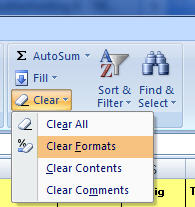
- The NEOSYS Report will now appear in excel in a text format.
Option 2: Importing Data into Excel (All Browsers)
- Copy Link from the URL

- Open Excel -> Data -> From Web
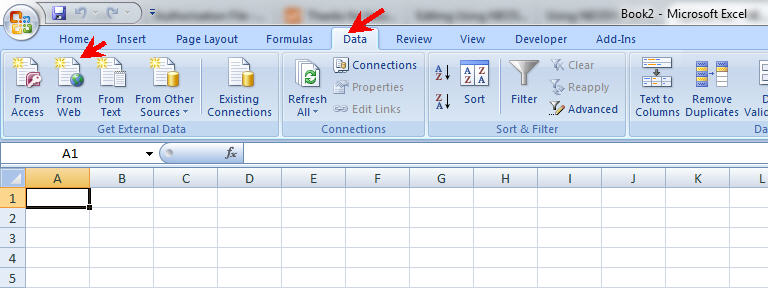
- Copy the URL in the address field -> Go -> Import
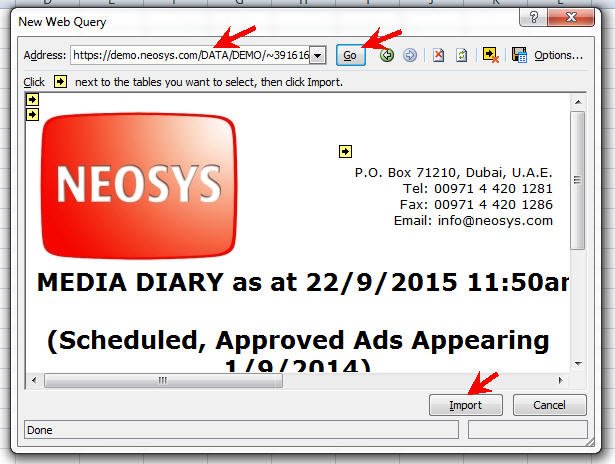
- Select the existing worksheet option -> OK
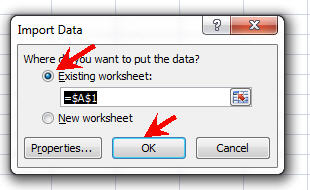
- The NEOSYS Report will now be pasted in excel in a text format
Option 3: Exporting Data into Excel directly (only IE)
- If you have not already done so, right click on the Internet Explorer tool bar and choose the following options
In case you are using Internet explorer 11, follow the screenshot below for this step: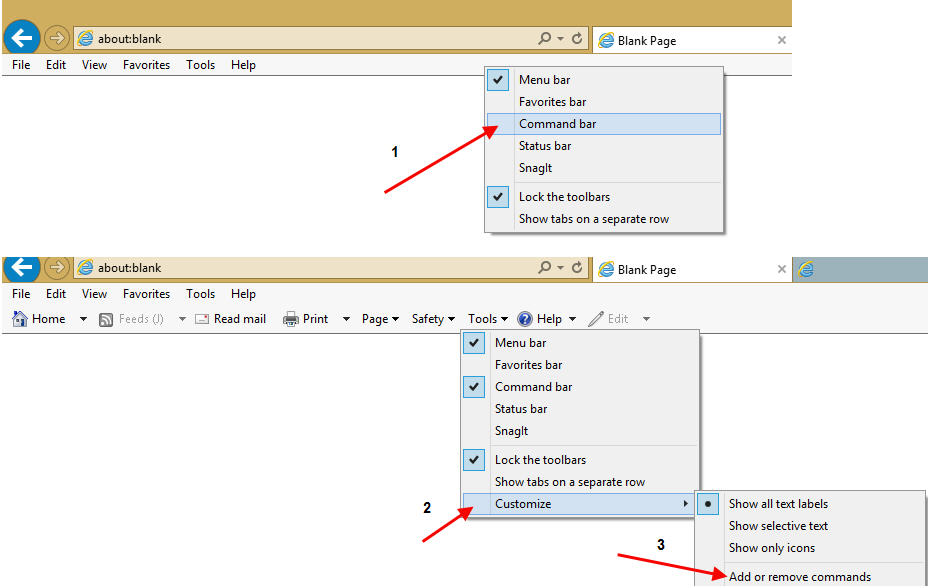
- Click Edit, Add, Close
- The Internet Explorer tool bar will now have an Edit button with a drop down to select Microsoft Office programs like Excel and Word
- Click on the "right arrow" at the top left corner (it will turn into a checkmark) and click on Options on the top right of your screen
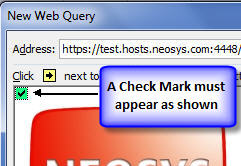
Check Mark 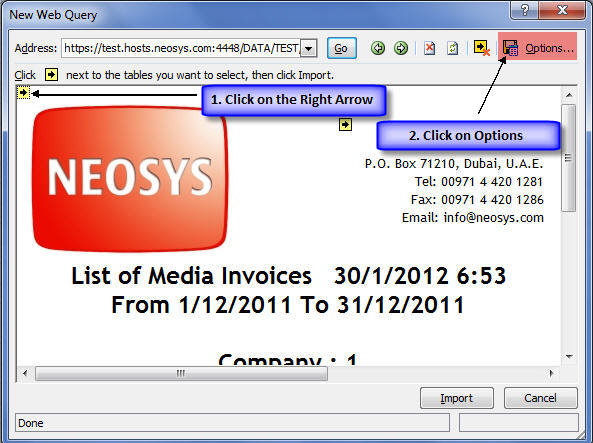
- Select the "None" option and click on Ok
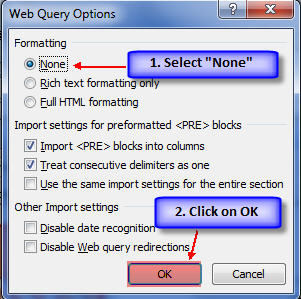
- Select the location to paste data and click on OK
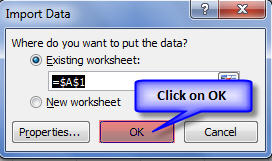
- The NEOSYS Report will now be pasted in excel in a text format.
Issues in Exporting to Excel
To troubleshoot Export to Excel, see Resolving ‘Export to Microsoft Excel’ in IE9, Excel 2009
Removing blank lines from Excel
In the Home menu > Find & Select > Go to Special > Blank Cells. This will select all the blank cells.
Then right-click on any of the selected cells, select Delete and select Entire Row. This delete all rows that contains blank cells.
These steps can be saved as a macro, so that it can be done easily in one step in the future.
Using Macros in Excel to edit NEOSYS reports
Generally when copying reports from NEOSYS to Excel, users might want to edit it further, e.g. clearing empty or unwanted columns and this task can be repetitive and time consuming to do it each time a report is copied to excel. Define macros in Excel to handle such tasks quickly. Below is an example showing how to create and reuse a macro to delete empty columns.
Steps to create a macro (one time procedure)
- Copy the report and paste it in an excel sheet. (Click on How to Copy a NEOSYS report in MS-Excel to see how to do this.)
- Make the Developer tab visible as shown below
For Excel 2007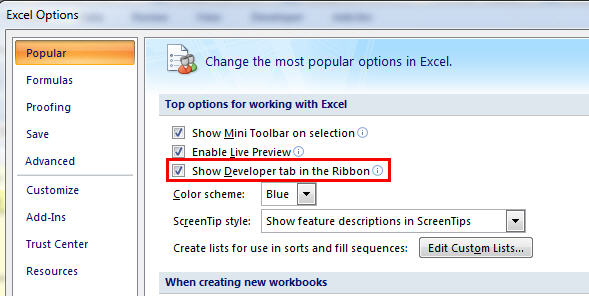
For Excel 2010/2013
a) Under Excel Options click on Customise Ribbon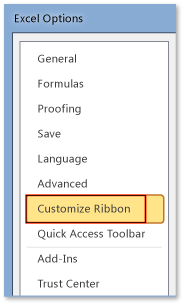
b) Tick the checkbox which says Developer Tools
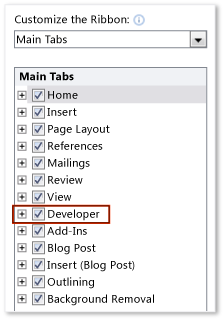
- Under the Developer Tab in Excel click Record Macro. Name the macro appropriately for easy reference. In this example the macro is to delete empty columns. Ensure "Personal Macro Workbook" is selected from the drop-down menu
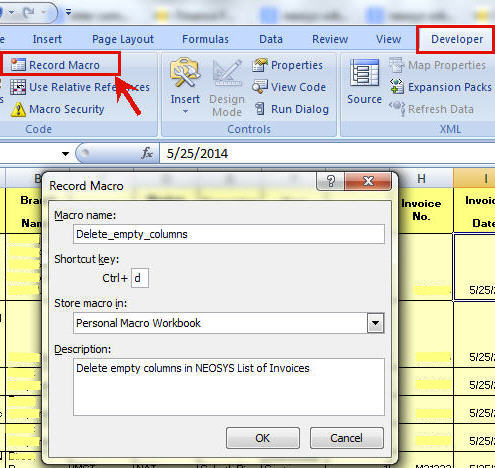
- Record your action which you want to be repeated later. The macro records all actions like scrolling, selecting cells, editing etc. For this example select entire columns in the spreadsheet that you intend to delete. Right click on any one of the columns and click on Delete to remove the unwanted columns
- Click on Stop Recording under Developer Tab
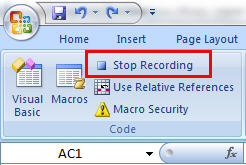
- Save changes to Personal Macro Workbook when prompted. This is to reuse the macro on other worksheets
Steps to reuse macro
- Copy the report and paste it in an excel sheet. (Click on How to Copy a NEOSYS report in MS-Excel to see how to do this.)
- Under the developer Tab click on Macros, select the macro and click Run to execute the tasks recorded earlier. You can also use the shortcut key you defined in the macro. You can also edit Macro definition by clicking Edit.
Opening new windows in new tabs in Internet Explorer 7
Unfortunately Microsoft have decided that this cannot be done programmatically and that the only way is to right click on the menu item and select "open in new tab".
Also surprising is that new tabs do not become the top window automatically unless you configure Internet Explorer as follows:
Tool, Options, Settings and check the option "Always Switch to New Tabs when they are Created"
Showing signatures for people who are not users of NEOSYS
You can issue documents on behalf of anybody by typing in their name as the executive when creating the document, however this does provide a signature.
Solution:
- Create NEOSYS users in the usual way to represent the “issuing” users except that they must not have an email address and therefore will not be able to get passwords or login.
- Upload signatures onto the User File for the issuing users. To update users other than yourself, you need to be authorised to do “USER UPDATE”
- When creating documents on behalf of issuing users, enter the user code of the issuing user as the Executive. The default executive/issuing user can be setup per client and/or brand in the Client/Brand File if desired.
How to automatically open all your favourite NEOSYS screens in one step
In most browsers, you can save and reopen a set of tabs on demand. The exact steps to follow depend on the browser you are using.
Setting up
- Open many tabs as you would like them to be reopened in future
- Right click any tab and choose "Save all tabs" - exact method varies per browser.
Using
- Open a new browser window (not tab) and login to NEOSYS
- Right click the favourites folder you saved above and choose "Open all in tabs"
Here is an example set of tabs for NEOSYS finance module.
- Change the "http://127.0.0.1/neosys2/" in the examples to your own browser address for NEOSYS
- You can modify the ending of the examples to open the specific documents in your own database
http://127.0.0.1/neosys2/finance/journals.htm?key=1*INV*214 http://127.0.0.1/neosys2/finance/journalaudit.htm http://127.0.0.1/neosys2/finance/recurringjournals.htm http://127.0.0.1/neosys2/finance/revaluationjournals.htm http://127.0.0.1/neosys2/finance/reversingjournals.htm http://127.0.0.1/neosys2/finance/journaltypes.htm http://127.0.0.1/neosys2/finance/vouchers.htm?key=REC*88*1 http://127.0.0.1/neosys2/finance/voucherlist.htm?WORDS_TO_SEARCH_FOR=HELP http://127.0.0.1/neosys2/finance/ledgerprint.htm?LEDGER_ACCOUNT_NO=BAMU http://127.0.0.1/neosys2/finance/accountreconciliation.htm?LEDGER_ACCOUNT_NO=BAMU http://127.0.0.1/neosys2/finance/listunalloc.htm http://127.0.0.1/neosys2/finance/charts.htm?key=GL http://127.0.0.1/neosys2/finance/chartlist.htm?LEDGER_CODE=PL http://127.0.0.1/neosys2/finance/charts.htm?MODE=REPORTDESIGN&CHART_CODE=PL http://127.0.0.1/neosys2/finance/trialbalance.htm?LEDGER_CODE=PL http://127.0.0.1/neosys2/general/reports.htm?module=finance&mode=financialstatements http://127.0.0.1/neosys2/finance/ledgerprint.htm?MODE=AGED&LEDGER_CODE=SDM1 http://127.0.0.1/neosys2/finance/ledgerprint.htm?MODE=FORECAST&LEDGER_CODE=SDM1 http://127.0.0.1/neosys2/finance/accountanalysis.htm?LEDGER_ACCOUNT_NO=BAMU http://127.0.0.1/neosys2/finance/taxreport.htm http://127.0.0.1/neosys2/finance/budgets.htm?LEDGER_CODE=PL http://127.0.0.1/neosys2/finance/clearallocated.htm http://127.0.0.1/neosys2/finance/opennewyear.htm http://127.0.0.1/neosys2/finance/taxes.htm
Screenshots of how to set it up in Internet Explorer:
Using Google to search NEOSYS wikis
Mediawiki's built in search is nowhere near as smart as Google's but Googles search often lists non-NEOSYS pages.
To make Google search only NEOSYS sites (or sites that refer to NEOSYS.COM) prefix the search with the following:
site: .neosys.com
for example
site: .neosys.com "Exchange Rate"
Note the leading .
Putting Exchange Rate in "" quotes searches for the exact phrase instead anywhere either word appears
NEOSYS links in different browsers
The NEOSYS access urls automatically redirect to different versions of NEOSYS depending on the browser you are using as each version is compatible to a particular browser. You only have to enter "url" in your browser and it will get redirected to the appropriate version depending on your browser.
url/1 is the old version to which no new developments are done. The option to access this old version will go away in the future.
url/2 is the new version that is accessible from Internet Explorer and Firefox.
url/3 is the new version that is accessible from Firefox and Google Chrome.
url given below is followed by /3 showing that the link has been copied from Firefox or Chrome.
https://test.hosts.neosys.com:4453/3/
Another example of a link below displays a user details page copied form Internet Explorer or Chrome where the access url is followed by "/2" which is then followed by the path to the user details html file.
So, basically /1, /2, /3 contain different versions of NEOSYS which get redirected to depending on your browser.
https://test.hosts.neosys.com:4453/2/neosys/users.htm


